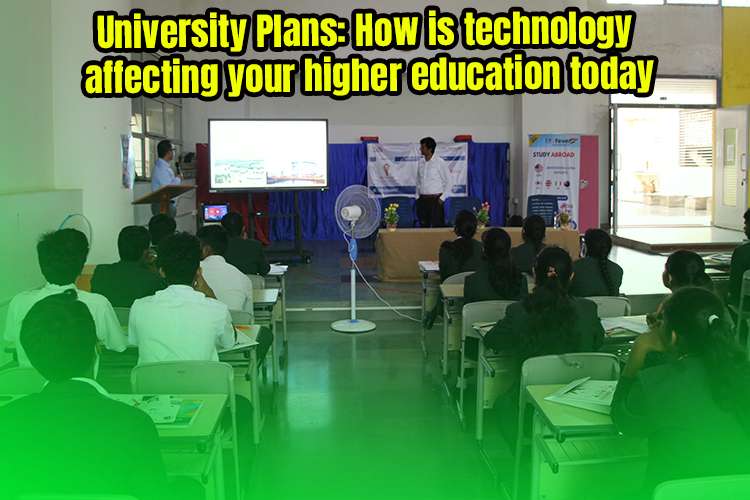As students begin their university journey, it’s important to think about how technology affects education. Technology has changed how we learn and teach in college and even in graduate and postgraduate degrees. In India, we’ve been using technology for distance learning for a while, but it used to be a backup plan. Now, because technology is better and online teaching is more convenient (especially due to the pandemic), students all over the country can study online for their bachelor’s and master’s degrees.
If you’re wondering what course to choose after twelfth-grade exams, universities worldwide use technology to offer us a suitable and quality education. As a result, when choosing a course or program do consider the implications of the degree in the real world.
How is technology being used in higher education?
Technology has completely changed how higher education works. It’s made learning easier for students and teaching better for teachers. Colleges and universities can give a really good education that lots of people can get. Here are a few ways technology is making higher education different:
1. Online courses –
Online learning has made education accessible to more people than ever before. Anyone can now pursue a degree from anywhere in the world, on their own schedule, and without going to a physical class. This helps more students, especially those who can’t do in-person classes, get higher education.
2. Learning management systems –
Learning Management Systems (LMS) are online platforms that allow teachers to upload course materials, create assignments, track student progress, and communicate with students. LMS is really helpful for teachers to teach and watch how students are doing. It’s also a main place for students to get course materials, see how they’re doing, and talk to their teachers and friends.
3. Hybrid learning –
Hybrid learning combines online and in-person instruction, providing students with the best of both worlds. It offers the flexibility of online learning while still providing the student with the opportunity to interact with teachers and peers in person. Hybrid learning is becoming increasingly popular as it allows students to personalize their learning experience and gain practical experience in their field of study without having to attend in-person classes full-time.
4. Virtual and augmented reality –
Virtual and Augmented Reality (VR/AR) technologies are changing how students learn by providing students with immersive, interactive, and engaging experiences. VR/AR has the potential to simulate realistic work environments, such as medical laboratories or engineering workshops, enabling students to gain practical experience in their field of study.
Technology’s impact on undergraduate and graduate programs
Today, learning has become borderless thanks to technology. Regardless of where you’re physically located, you can gain a degree from the best institutes globally. This makes education deeply accessible, and inexpensive for students from all stratas of society. Regardless of what you want to learn as an undergraduate or postgraduate student–technology impacts all modes of learning.
1. Expanding opportunities for distance learning –
Online education allows students worldwide to pursue graduate programs. Distance learning and online courses eliminate the need to relocate, making education accessible. Flexibility enables students to balance studies with work and commitments. Through online chats and virtual discussions, students connect instantly for group projects. Technology in undergrad programs teaches vital skills, readying students for the digital job market. Universities now provide courses for essential technical and digital skills, crucial for success in many industries. Right from MOOCs, to learning from the best teachers through free programs, students can engage with peers anywhere in the world.
2. Simplifying research and data analysis –
With the help of technology, graduate students can conduct research and analyze data more efficiently. Online databases, tools, and software simplify collecting and analyzing data from different sources. This speeds up research and enhances accuracy.
While technology greatly impacts graduate and postgraduate education, concerns exist about replacing professors and lowering education quality. This cannot happen yet, because building a course curriculum that reflects the real world, alongside updating the content based on the class cohort is a skill in itself.
3. Curriculum changes for offline versus online pedagogy –
Today, in addition to upgrading the course content for offline versus online modes of instruction, colleges are also looking at integrating technology into their instructional material directly. With the growth of Youtube, CMS platforms and other tech, it’s easier to create a repository of material which students can keep referencing, even after they graduate.
Thanks to the tech, the time taken to create content, and making it more accessible to thousands of people has become easier. But what technology hasn’t fixed are for the learning needs of every student based on individual subjects. For example, someone who excels at statistics might struggle with language and vice-versa. While at a school level, learning programs are certainly adaptive, this hasn’t yet trickled down to graduate level education.
Pros and cons of technology reliance in college
As students plan for college, it’s smart to think about how relying on technology can help or hurt. Tech has brought us a bunch of good stuff, but it also has some downsides.
The Pros:
- Increased accessibility: Technology enables easier access to education, especially for those who can’t easily reach campus or have other commitments. Online courses and digital materials open up higher education to a wider range of students.
- Flexibility: With so many options for online and distance learning, technology has made it easier for students to fit their education around their personal and professional lives.
- Better learning experience: Technology changes how we teach and learn, making education more interesting and creative. Interactive tools, multimedia presentations, and virtual simulations enhance the learning process.
The Cons
- Less face-to-face interaction: While technology can definitely enhance communication, it can also lead to reduced face-to-face interaction. This can be detrimental to a student’s social growth and chances for teamwork.
- Overdependence on technology: Although tech simplifies life, heavy dependence can be problematic. When technology fails, it can be difficult to adapt and continue learning without relying on it.
- Potential for distraction: With so many digital distractions available, it can be easy for students to lose focus on their studies.
Maintain a balance between tech and traditional education values. Remember that there is value in personal interaction, teamwork, and practical learning as you think about tech in your university journey. While tech offers benefits, don’t forget these crucial aspects.
Technology has brought benefits to higher education, there are also downsides to relying too much on it. For example, some students might struggle with the lack of in-person interaction in online or hybrid courses. Concerns about the quality of online education also exist. Moreover, teachers may feel burdened by the work needed to develop and handle online courses. Despite these issues, technology is vital in higher education. Colleges and universities must keep using it to stay competitive and relevant.




